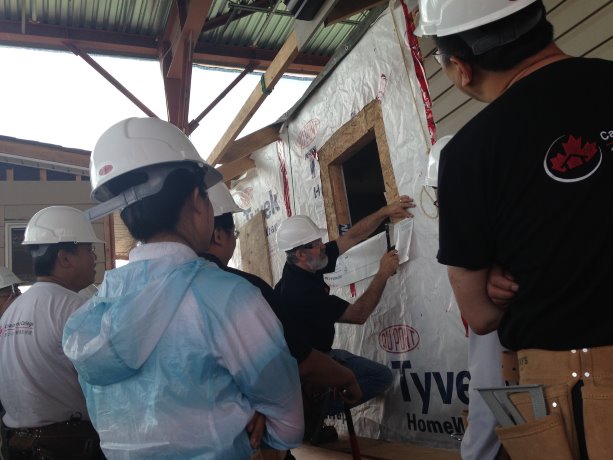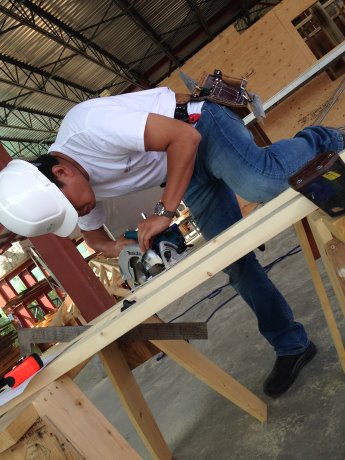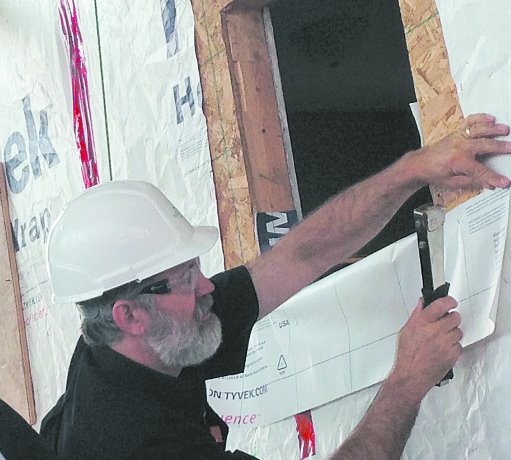A group of construction industry professionals from China in white hard hats huddled around a square hole cut in the side of a mock home in Chilliwack, B.C.
Mark Ryan, a carpentry instructor at the University of the Fraser Valley for more than 20 years, smoothly stapled and cut house wrap around the window hole as visitors filmed with cameras and cell phones.
An interpreter described and explained what he was doing.
The group is wrapping up their three week visit to Canada, where they have been learning the nuts and bolts of wood frame construction.
The students said they came to learn because China, with its high pollution and history of severe earthquakes, could greatly benefit from using the material.
"In Chinese education, we only have class in the classroom, not outside, but here we use our hands to build a true house. It is amazing," said Peter Hu, a Chinese project manager.
He plans to teach others how to build with wood when he returns to China.
Hu explained that wood buildings could help solve some of the country’s biggest problems.
During an earthquake, wood is far more resistant than brick and concrete, the predominant building materials in China.
Hu also believes that as wood technology progresses, highrises could be built with it, a much greener option for China’s growing population.
"This technology could be very useful for the Chinese," he said.
Dong Baao is a Chinese home furnishings designer, who travelled to Canada with the team to expand her wood building prowess.
"(The) first time I came to this project, I was like a brand new student to get the knowledge of the wood, but through the three weeks I know more, that is fantastic," she said.
Baao knows all too well the devastation earthquakes can do to concrete and brick buildings.
She works in Sichuan province, an area hit hard by earthquakes in 2008.
Baao hopes wood building will take hold to prevent more damage. She also believes wood could help reduce pollution in China.
"It’s caused lots of pollution in China, pm (particulate matter) levels are very high," she said concerning concrete construction.
"Maybe it is the solution for government to do something."
Organized in conjunction with the Chinese National Ministry of Urban & Rural Housing Development, the program is sponsored by 11 Chinese vocational schools, nine building companies and Canada Wood, an industry coalition that represents Canada’s forest sector’s interests in offshore markets.
Ryan said the program is the first of its kind.
"We are just trying to give them more of a flavour of how we would do it here in Canada," he said.
He’s demonstrated how to build a wood frame, interior/exterior walls, roofing, flooring, windows and stairs.
The team also visited manufacturing and jobsites.
"They build over there primarily with concrete which is great for their highrise construction," he said.
It’s a building culture he’s been able to experience several times during teaching visits with the program.
During his most recent trip a month ago, he was able to visit a city completely destroyed by an earthquake.
Most of the buildings were the favoured concrete and brick.
"You could clearly see the parts of the buildings that failed and a lot of it was around the design with the clay bricks," he said.
"We know wood frame stands up much, much better to earthquakes."
Build materials isn’t the only difference in construction culture.
Ryan also noted that many of the team members were amazed at how exact the Canadian standards are.
"One of the things they learned is the level of accuracy we require in our building," he said.
"We had to be accurate right down to the millimetre in some cases."
The visit is wrapping up, and soon the Chinese building professionals will be heading back home with a new set of knowledge and skills.
Ryan said he believes the program will continue to grow in the future with more visits back and forth.
"They like to work hard and play hard," he said. "They were a very enjoyable group to teach and I had a lot of fun."

1/3
Russell Hixson
2/3












Recent Comments
comments for this post are closed